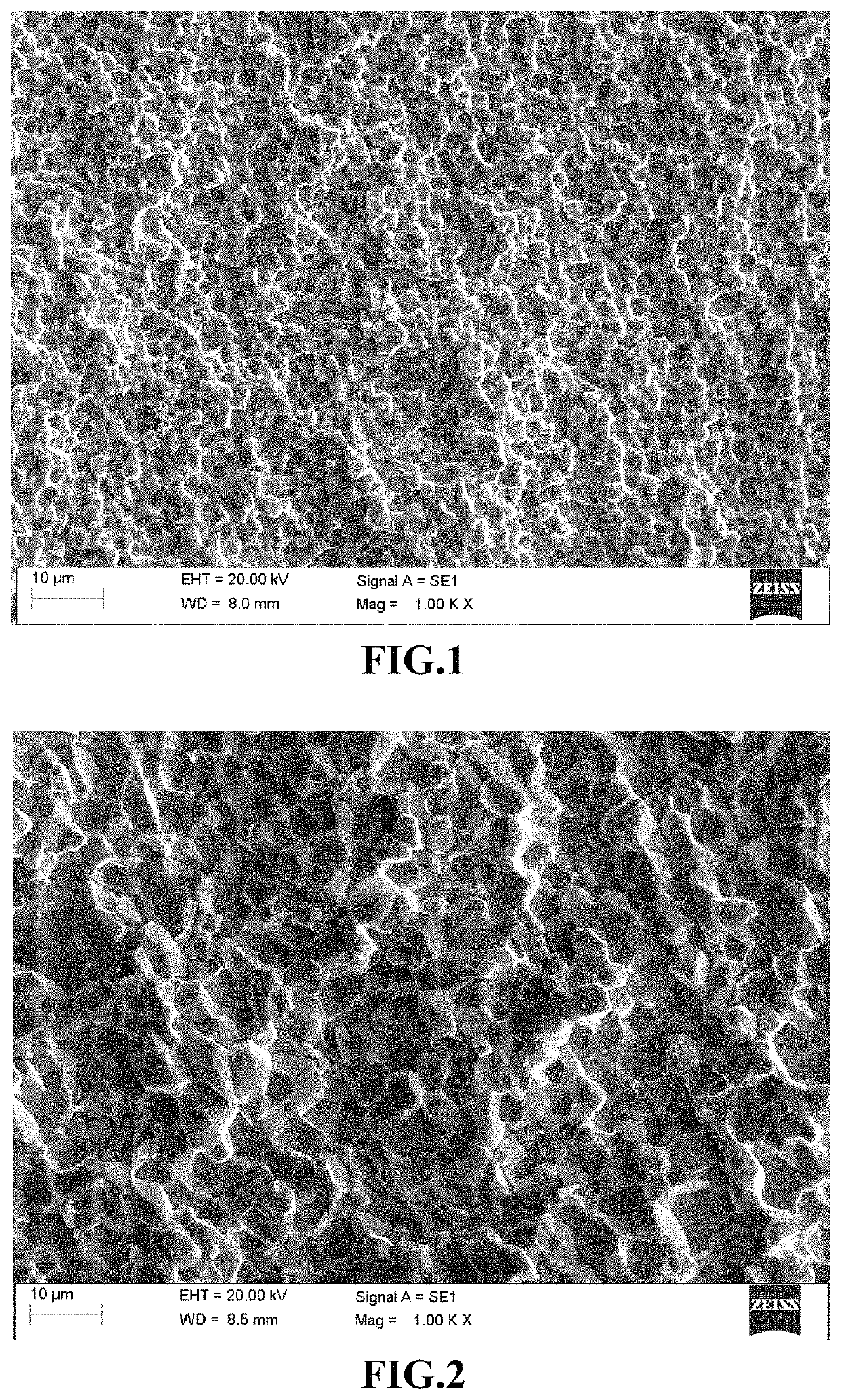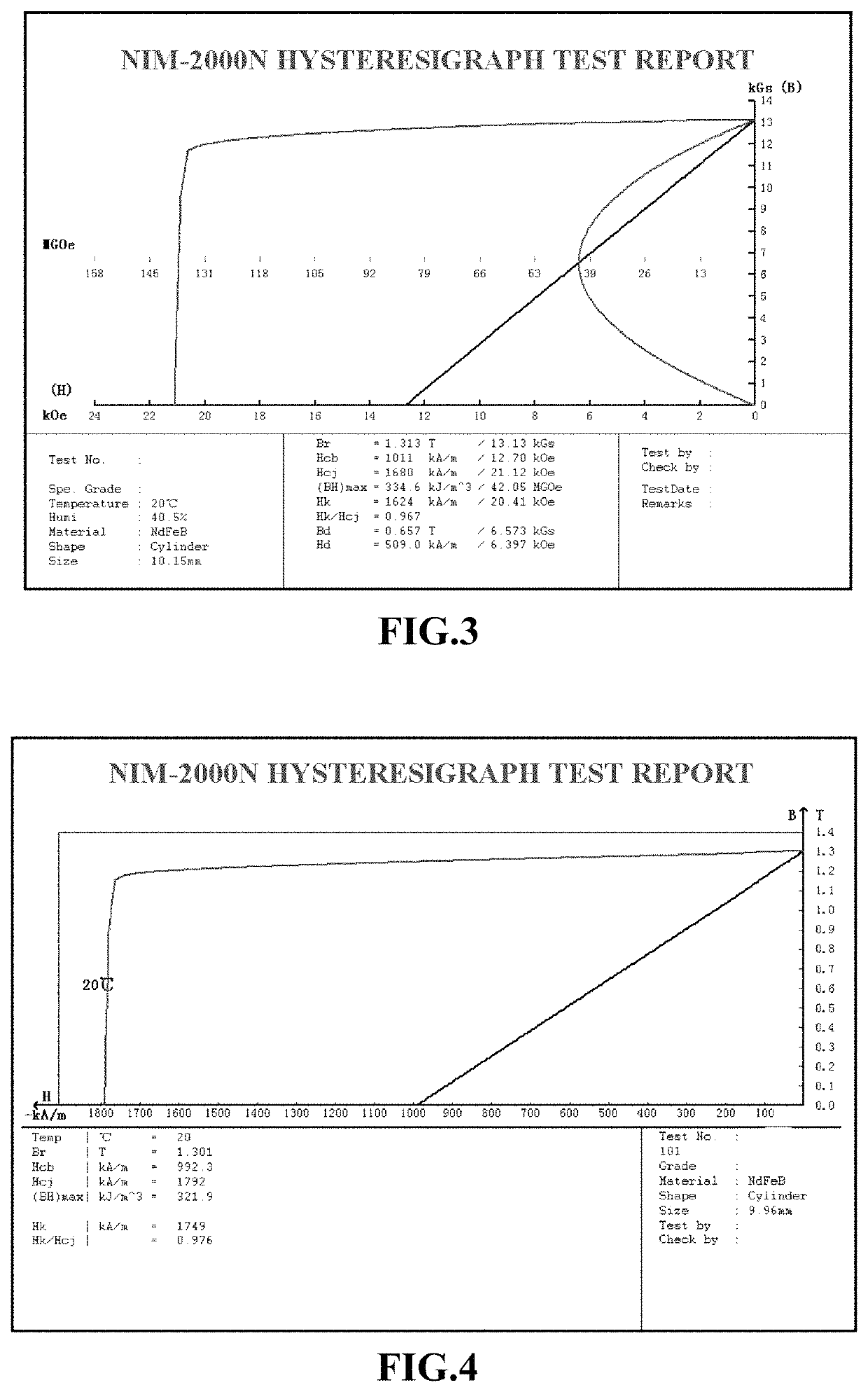Sintered magnet composition without heavy rare earth element and a method of making the sintered magnet
a rare earth element and composition technology, applied in the field of preparation compositions of sintered rare earth magnets, can solve the problems of low magnet performance, scarce heavy rare earth elements, high material cost, etc., and achieve the effect of improving magnetic properties and low material cos
- Summary
- Abstract
- Description
- Claims
- Application Information
AI Technical Summary
Benefits of technology
Problems solved by technology
Method used
Image
Examples
implementing example 1
[0024]A raw powder including Nd—Pr being present 32.5 wt. %, B being present 0.8 wt. %, Al being present 0.4 wt. %, Co being present 0.7 wt. %, Cu being present 0.3 wt. %, Ga being present 0.2 wt. %, and Fe being present as a balance. The raw powder is then melted to produce a molten alloy. Next, the molten alloy is then formed into an alloy sheet having a uniform thickness of between 0.1 mm to 0.6 mm using a thin strip casting process. Then, then alloy sheet is disintegrated to produce an alloy powder. The step of disintegrating is further defined as subjecting the alloy sheet in a hydrogen atmosphere in a hydrogen decrepitation process under a predetermined pressure of between 0.2 MPa for a duration of 3.5 hours. The step of disintegrating further includes a step of degassing the hydrogen at a predetermined temperature of 550° C.
[0025]The alloy powder is then mixed with a lubricant having a weight content of 0.1 wt. %. Next, the alloy powder with the lubricant is pulverized by sub...
implementing example 2
[0027]A raw powder including Nd—Pr being present 33 wt. %, B being present 0.9 wt. %, Al being present 0.6 wt. %, Co being present 0.7 wt. %, Cu being present 0.4 wt. %, Ga being present 0.15 wt. %, and Fe being present as a balance. The raw powder is then melted to produce a molten alloy. Next, the molten alloy is then formed into an alloy sheet having a uniform thickness of between 0.1 mm to 0.6 mm using a thin strip casting process. Then, then alloy sheet is disintegrated to produce an alloy powder. The step of disintegrating is further defined as subjecting the alloy sheet in a hydrogen atmosphere in a hydrogen decrepitation process under a predetermined pressure of between 0.2 MPa for a duration of 3.5 hours. The step of disintegrating further includes a step of degassing the hydrogen at a predetermined temperature of 550° C.
[0028]The alloy powder is then mixed with a conventional lubricant having a weight content of 0.1 wt. %. Next, the alloy powder with the lubricant is pulve...
implementing example 3
[0030]A raw powder including Nd—Pr being present 34 wt. %, B being present 0.8 wt. %, Al being present 0.4 wt. %, Co being present 0.6 wt. %, Cu being present 0.5 wt. %, Ga being present 0.4 wt. %, and Fe being present as a balance. The raw powder is then melted to produce a molten alloy. Next, the molten alloy is then formed into an alloy sheet having a uniform thickness of between 0.1 mm to 0.6 mm using a thin strip casting process. Then, then alloy sheet is disintegrated to produce an alloy powder. The step of disintegrating is further defined as subjecting the alloy sheet in a hydrogen atmosphere in a hydrogen decrepitation process under a predetermined pressure of between 0.15 MPa for a duration of 3.5 hours. The step of disintegrating further includes a step of degassing the hydrogen at a predetermined temperature of 550° C.
[0031]The alloy powder is then mixed with a conventional lubricant having a weight content of 0.05 wt. %. Next, the alloy powder with the lubricant is pulv...
PUM
| Property | Measurement | Unit |
|---|---|---|
| particle size | aaaaa | aaaaa |
| particle size | aaaaa | aaaaa |
| magnetic field | aaaaa | aaaaa |
Abstract
Description
Claims
Application Information
 Login to View More
Login to View More - R&D
- Intellectual Property
- Life Sciences
- Materials
- Tech Scout
- Unparalleled Data Quality
- Higher Quality Content
- 60% Fewer Hallucinations
Browse by: Latest US Patents, China's latest patents, Technical Efficacy Thesaurus, Application Domain, Technology Topic, Popular Technical Reports.
© 2025 PatSnap. All rights reserved.Legal|Privacy policy|Modern Slavery Act Transparency Statement|Sitemap|About US| Contact US: help@patsnap.com


